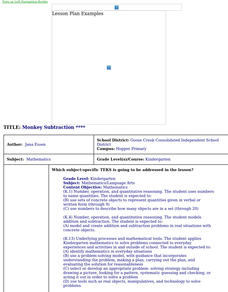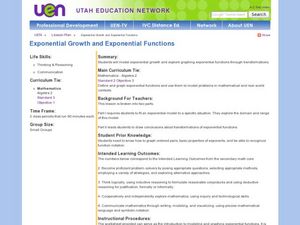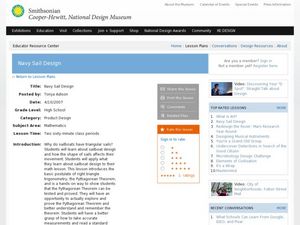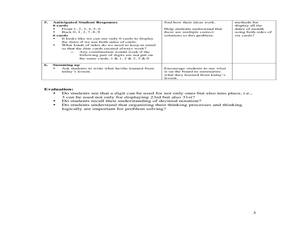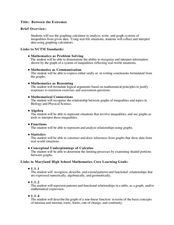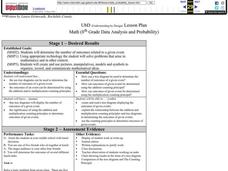Inside Mathematics
Party
Thirty at the party won't cost any more than twenty-five. The assessment task provides a scenario for the cost of a party where the initial fee covers a given number of guests. The class determines the cost for specific numbers of guests...
Inside Mathematics
Suzi's Company
The mean might not always be the best representation of the average. The assessment task has individuals determine the measures of center for the salaries of a company. They determine which of the three would be the best representation...
Inside Mathematics
Quadrilaterals
What figure is formed by connecting the midpoints of the sides of a quadrilateral? The geometry assessment task has class members work through the process of determining the figure inscribed in a quadrilateral. Pupils use geometric...
Curated OER
Roman Bernardo: Solving Linear Equations
Mathematicians use an inquiry method to solve linear equations. In this linear equations lesson, young scholars practice solving equations using addition, subtraction, multiplication and division. They solve multi-step equations and...
Curated OER
Divisibility Rules
In this divisibility rules worksheet, students solve 18 different problems that include applying the divisibility rules to each. First, they identify the hypothesis and conclusion in logical deduction. Then, students determine the...
Curated OER
Compare and Arrange Whole Numbers Up to 100
Number whizzes investigate integers by arranging them in a specific order. They utilize whole numbers which are given to them and then put them in order up to 100. They also practice using "greater than" or "lesser than" symbols.
Curated OER
Taxes: Where Does Your Money Go?
Pupils study taxes and the role that they place in our lives. In this economic lesson, students explore the reality of taxes, how they work, why we pay them, where the money goes and how to make the most of the money you pay into taxes...
Utah Education Network (UEN)
It's All Just Similar to Me
Middle schoolers explore the concept of similar figures. In this similar figures lesson, pupils calculate scale factors of similar triangles. They find missing sides of triangles, and measure angles using protractors and measure sides of...
Curated OER
Grab Bags
Eighth graders graph two inequalities with a single variable. They include drawing the intersection or union of inequalities on a number line. Students solve the linear equations using properties of equality and inequality. The lesson...
Curated OER
Monkey Subtraction
Students listen to the book Five Little Monkeys Sitting In a Tree, identify written numbers 0-9 and the symbol for subtraction; students subtract two single digit numbers using manipulatives, and recite the corresponding number sentence.
Curated OER
Sorting
Students explore how to logically sort and store information in order to make it easy to manage and easily retrieved. They explore methods they can use to organize and manage information.
Curated OER
Bubblegum balls
Learners look for patterns to solve problems involving statistics using different colored gumballs. They should be able to look for and find out all the possible outcomes based upon inference and trials.
Curated OER
Lollies, Lollies, Lollies
Students listen to the problem read to them. They answer some simple questions using number sentences. They then compose a written record of the solution and share their approaches used.
Curated OER
No-Three-In-A-Line Again
Students interpret information and results in context while using words and symbols to generalize patterns. They use symmetry and angle properties of polygons to solve practical problems and identifying invariant properties under...
Curated OER
Exponential Growth and Exponential Functions
Pupils explore the concept of exponential functions. In this exponential functions lesson, students model exponential growth about a high school population using an applet. Pupils manipulate the applet to show the effect that a change in...
Curated OER
Navy Sail Design
Learners use the Pythagorean Theorem to explore sailboat design. In this Pythagorean Theorem lesson, two sides of a triangular sail are measured, and the theorem is used to calculate the third side. A worksheet, bulletin board design,...
Curated OER
Investigating Quadrilaterals
Fourth graders discuss the various attributes of quadrilaterals. In groups, they use the attributes to sort quadrilaterals into different classes and a hierarchy. They review the new vocabulary and attributes with a partner to end the...
Curated OER
Putting Your Best Foot Forward
Third graders measure their feet and their parents' feet, record data on computer-generated graphs, and calculate and record mean, median, and mode.
Curated OER
How many cards do we need to display the dates of the month on the wall?
Students determine how many number cards are needed to display the dates of the month. For this place value notation lesson, students write numbers on blank cards to see how many are needed of each number to makes all the dates of the...
Curated OER
Representing Rational Numbers
Seventh graders explore rational numbers. In this fractions, decimals, and percents instructional activity, 7th graders identify and compare equivalencies between fractions, decimals, and percents. Students use hands-on activities to...
Curated OER
An Introduction to Public Key Cryptography
Young scholars secure information online using cryptography. In this algebra lesson, students use RSA technology to encrypt information on the internet. They use modular reduction of natural numbers to understand prime number theory.
Curated OER
Between The Extremes
Students analyze graphs for specific properties. In this algebra lesson, students solve equations and graph using the TI calculator. They find the different changes that occur in each graph,including maximum and minimum.
Curated OER
Batter Up
Students use a variety of strategies to figure out the cost of baseball tickets. They use a combination chart, notebook notation, etc. to find the cost of their family to attend a Cardinal's game in St. Louis.
Curated OER
Grade Data Analysis and Probability
Eighth graders display the outcome of given events by creating and reading tree diagram. They explain the relationship between addition and multiplication.











